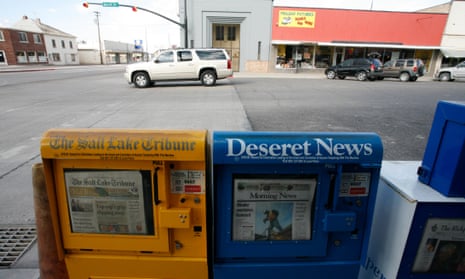When a local newspaper closes, the cost of government increases. That’s the conclusion of new survey from Notre Dame’s Mendoza College of Business, which draws a direct line between loss of the watchful eyes of local newspapers and a decline in government efficiency.
Paul Gao, a professor of finance at the college, said he got the idea for the study while watching John Oliver’s Last Week Tonight about the decline of local newspapers almost two years ago.
The result of that study, Financing Dies in Darkness? The Impact of Newspaper Closures on Public Finance, argues there is a direct correlation between the loss of a local paper and higher costing – or less efficient – government.
Dozens of local newspapers have closed, reduced their printing schedule or gone online in recent years. Circulation numbers have fallen approximately 27% from 2003 to 2014, according to the Pew Research Center, and there has been a 35% decline in statehouse reporters.
Those reductions have come with a cost, according to Gao. A local newspaper, the authors conclude, holds an important and unique role in the proper functioning of the government and markets.
“Some people told us a local newspaper doesn’t have an important local role. Others said they may play a role, but something else, some other alternative source of media, will come in,” Gao told the Guardian. “We think the local newspaper plays an important and unique role that cannot be easily replaced by an online source or national news media.”
Gao’s team looked at some 1,600 English-language newspapers serving 1,266 counties in the US between 1996-2015 and excluded counties without a daily local newspaper.
In one example, the report looks at the closure in 2009 of Denver’s Rocky Mountain News. The paper had provided extensive coverage of local government issues, including an audit of questionable federal funds allocated to the sheriff’s department, and a series of other handshake deals.
Gao’s team looked at how tax dollars were being spent while the paper was being published and then again after the paper had closed. The researchers concluded that Rocky Mountain News stories had served as a watchdog agent. Without it, the spread or yield of newly issued local municipal bonds increased by 37 basis points.
In other words, local government’s cost of borrowing money – and therefore risk – had increased once the paper had gone.
The researchers also looked at the Cincinnati Post, which closed in 2007. In that instance too, the median yield spread for newly issued local municipal bonds increased by about 66.1 basis points – another indication, according to the authors, that public finances suffer when a newspaper closes.
Gao does not offer any particular solution – his job, he says, is just to raise the issue.
“We can’t offer a solution because this is to do with public good, not statistical analysis,” he said. “You cannot effectively charge public good. So we hope this paper raises awareness of the importance of a local newspaper. It’s like a public good or an environmental protection. Good to have but, we also recognize, ultimately costly.”
